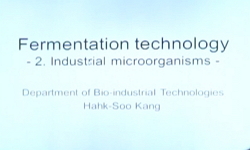Panax ginseng (P. ginseng C.A. Meyer, Araliaceae) is used as a therapeutic agent for various diseases. P. ginseng saponins, known as ginsenosides, are the main bioactive compounds responsible for its pharmacological activities. In this work, we have d...
http://chineseinput.net/에서 pinyin(병음)방식으로 중국어를 변환할 수 있습니다.
변환된 중국어를 복사하여 사용하시면 됩니다.
- 中文 을 입력하시려면 zhongwen을 입력하시고 space를누르시면됩니다.
- 北京 을 입력하시려면 beijing을 입력하시고 space를 누르시면 됩니다.



Comparison of the Effects of Nonfermented and Fermented Panax ginseng Root Against Hypertriglycemia in High-Fat Diet-Fed Mice
한글로보기https://www.riss.kr/link?id=A105289742
- 저자
- 발행기관
- 학술지명
- 권호사항
-
발행연도
2018
-
작성언어
English
- 주제어
-
등재정보
KCI등재,SCOPUS,SCIE
-
자료형태
학술저널
-
수록면
317-323(7쪽)
-
KCI 피인용횟수
1
- DOI식별코드
- 제공처
-
0
상세조회 -
0
다운로드
부가정보
다국어 초록 (Multilingual Abstract)
Panax ginseng (P. ginseng C.A. Meyer, Araliaceae) is used as a therapeutic agent for various diseases. P. ginseng saponins, known as ginsenosides, are the main bioactive compounds responsible for its pharmacological activities. In this work, we have developed a new method of P. ginseng root processing termed solid-state fermentation and examined its effects compared with nonfermented P. ginseng. Mice were fed a high-fat diet (HFD) to induce hyperlipidemia and then received 100 mg·kg bw−1·day−1 of fermented or nonfermented P. ginseng orally for 3 weeks. We assessed the activities of lipogenic pathways and lipid levels in the liver and plasma. The administration of either nonfermented or fermented P. ginseng improved hepatic lipid transfer protein profiles. Nonfermented P. ginseng exhibited significant effects on the regulation of lipid synthesis and oxidation. However, apolipoprotein A4 (apoA4) expression was increased by the administration of fermented P. ginseng. When ginsenosides were analyzed by high-performance liquid chromatography (HPLC), the amounts of the ginsenosides, Rg2, Rc, Rh1(S), Rh1(R), and Rd, were increased by fermentation, with Rd becoming a major constituent of fermented P. ginseng. These findings imply that nonfermented P. ginseng improves hypertriglycemia in HFD-fed mice through regulation of the hepatic lipogenic pathway. In contrast, the effects of fermented P. ginseng were mediated through increased apoA4, leading to decreased triglycerides. The HPLC profiles of ginsenosides suggest that the compositional changes in P. ginseng caused by fermentation processing could be useful in the development of novel triglyceride-lowering therapies.
참고문헌 (Reference)
1 Yokozawa T, "Therapeutic potential of heat-processed Panax ginseng with respect to oxidative tissue damage" 1 : 30-44, 2007
2 주일우, "The Influence of Sam-Chil-Geun (Panax Notoginseng) on the Serum Lipid Levels and Inflammations of Rats with Hyperlipidemia Induced by Poloxamer-407" 연세대학교의과대학 51 (51): 504-510, 2010
3 Kang KS, "Study on the nitric oxide scavenging effects of ginseng and its compounds" 54 : 2558-2562, 2006
4 Matsuura H, "Study of red ginseng: New glucosides and a note on the occurrence of maltol" 32 : 4674-4677, 1984
5 Pandey A, "Solid-state fermentation" 13 : 81-84, 2003
6 Yamamoto M, "Serum HDL-cholesterol-increasing and fatty liver-improving actions of Panax ginseng in high cholesterol diet-fed rats with clinical effect on hyperlipidemia in man" 11 : 96-101, 1983
7 Kersten S, "Roles of PPARs in health and disease" 405 : 421-424, 2000
8 Duverger N, "Protection against atherogenesis in mice mediated by human apolipoprotein A-IV" 273 : 966-968, 1996
9 Barbier O, "Pleiotropic actions of peroxisome proliferator-activated receptors in lipid metabolism and atherosclerosis" 22 : 717-726, 2002
10 Yamamoto M, "Plasma lipid-lowering action of ginseng saponins and mechanism of the action" 11 : 84-87, 1983
1 Yokozawa T, "Therapeutic potential of heat-processed Panax ginseng with respect to oxidative tissue damage" 1 : 30-44, 2007
2 주일우, "The Influence of Sam-Chil-Geun (Panax Notoginseng) on the Serum Lipid Levels and Inflammations of Rats with Hyperlipidemia Induced by Poloxamer-407" 연세대학교의과대학 51 (51): 504-510, 2010
3 Kang KS, "Study on the nitric oxide scavenging effects of ginseng and its compounds" 54 : 2558-2562, 2006
4 Matsuura H, "Study of red ginseng: New glucosides and a note on the occurrence of maltol" 32 : 4674-4677, 1984
5 Pandey A, "Solid-state fermentation" 13 : 81-84, 2003
6 Yamamoto M, "Serum HDL-cholesterol-increasing and fatty liver-improving actions of Panax ginseng in high cholesterol diet-fed rats with clinical effect on hyperlipidemia in man" 11 : 96-101, 1983
7 Kersten S, "Roles of PPARs in health and disease" 405 : 421-424, 2000
8 Duverger N, "Protection against atherogenesis in mice mediated by human apolipoprotein A-IV" 273 : 966-968, 1996
9 Barbier O, "Pleiotropic actions of peroxisome proliferator-activated receptors in lipid metabolism and atherosclerosis" 22 : 717-726, 2002
10 Yamamoto M, "Plasma lipid-lowering action of ginseng saponins and mechanism of the action" 11 : 84-87, 1983
11 Desvergne B, "Peroxisome proliferator-activated receptors: Nuclear control of metabolism" 20 : 649-688, 1999
12 Friedman M, "Nutritional consequences of food processing" 56 : 350-352, 2003
13 Goldberg IJ, "Lipoprotein apoC-II activation of lipoprotein lipase" 265 : 4266-4272, 1990
14 Kang KS, "Increase in the free radical scavenging activity of ginseng by heat-processing" 29 : 750-754, 2006
15 Yang JW, "Ginsenoside Rc promotes anti-adipogenic activity on 3T3-L1 adipocytes by down-regulating
16 Park S, "Ginsenoside
17 Attele AS, "Ginseng pharmacology: Multiple constituents and multiple actions" 58 : 1685-1693, 1999
18 Zhang L, "Ginseng and obesity: Observations and understanding in cultured cells, animals and humans" 44 : 1-10, 2017
19 Sonnenborn U, "Ginseng (Panax ginseng C.A. Meyer)" 2 : 3-14, 1991
20 Park CH, "Evaluation of 7-O-galloyl-d-sedoheptulose, isolated from Corni Fructus, in the adipose tissue of type 2 diabetic db/db mice" 89 : 131-142, 2013
21 Sakakibara K, "Effect of ginseng saponins on cholesterol metabolism. I. The level and the synthesis of serum and liver cholesterol in rats treated ginsenosides" 23 : 1009-1016, 1975
22 Lopez-Miranda J, "Dietary, physiological, genetic and pathological influences on postprandial lipid metabolism" 98 : 458-473, 2007
23 Sievenpiper JL, "Decreasing, null and increasing effects of eight popular types of ginseng on acute postprandial glycemic indices in healthy humans; the role of ginsenosides" 23 : 248-258, 2004
24 Amagase H, "Clarifying the real bioactive constituents of garlic" 136 : 716S-725S, 2006
25 Hikino H, "Changes of alkaloid composition and acute toxicity of Aconitum roots during processing" 97 : 359-366, 1977
26 Yun TK, "Brief introduction of Panax ginseng C.A. Meyer" 16 : S3-S5, 2001
27 Xiong Y, "Antiobesity and antihyperglycemic effects of ginsenoside
28 Yamamoto M, "Anti-atherogenic action of Panax ginseng in rats and in patients with hyperlipidemia" 45 : 149-, 1982
29 Steinmetz A, "Activation of lecithin: Cholesterol acyltransferase by human apolipoprotein A-IV" 260 : 2258-2264, 1985
30 Yahagi N, "Absence of sterol regulatory element-binding protein-1 (SREBP-1) ameliorates fatty livers but not obesity or insulin resistance in
31 Folch J, "A simple method for the isolation and purification of total lipids from animal tissues" 226 : 497-509, 1957
32 Park JH, "A new processed ginseng with fortified activity" Korean Society of Ginseng 146-159, 1998
동일학술지(권/호) 다른 논문
-
- 한국식품영양과학회
- 반순현
- 2018
- KCI등재,SCOPUS,SCIE
-
- 한국식품영양과학회
- 유한뉘
- 2018
- KCI등재,SCOPUS,SCIE
-
- 한국식품영양과학회
- 윤금주
- 2018
- KCI등재,SCOPUS,SCIE
-
- 한국식품영양과학회
- Ya-Nan Liu
- 2018
- KCI등재,SCOPUS,SCIE
분석정보
인용정보 인용지수 설명보기
학술지 이력
| 연월일 | 이력구분 | 이력상세 | 등재구분 |
|---|---|---|---|
| 2023 | 평가예정 | 해외DB학술지평가 신청대상 (해외등재 학술지 평가) | |
| 2020-01-01 | 평가 | 등재학술지 유지 (해외등재 학술지 평가) |  |
| 2014-06-24 | 학회명변경 | 한글명 : 한국식품영양과학회지 -> 한국식품영양과학회영문명 : Journal of the Korean Society of Food Science and Nutrition -> The Korean Society of Food Science and Nutrition |  |
| 2014-04-02 | 학회명변경 | 한글명 : 한국식품영양과학회 -> 한국식품영양과학회지영문명 : 미등록 -> Journal of the Korean Society of Food Science and Nutrition |  |
| 2013-10-01 | 평가 | SCOPUS 등재 (등재유지) |  |
| 2010-01-01 | 평가 | SCI 등재 (등재유지) |  |
| 2007-01-01 | 평가 | 등재학술지 선정 (등재후보2차) |  |
| 2006-01-01 | 평가 | 등재후보 1차 PASS (등재후보1차) |  |
| 2005-01-20 | 학술지등록 | 한글명 : Journal of Medicinal Food외국어명 : Journal of Medicinal Food |  |
| 2005-01-20 | 학술지등록 | 한글명 : Journal of Medicinal Food외국어명 : Journal of Medicinal Food |  |
| 2004-01-01 | 평가 | 등재후보학술지 선정 (신규평가) |  |
학술지 인용정보
| 기준연도 | WOS-KCI 통합IF(2년) | KCIF(2년) | KCIF(3년) |
|---|---|---|---|
| 2016 | 1.88 | 0.33 | 1.35 |
| KCIF(4년) | KCIF(5년) | 중심성지수(3년) | 즉시성지수 |
| 1.09 | 0.84 | 0.536 | 0.08 |





 KCI
KCI



